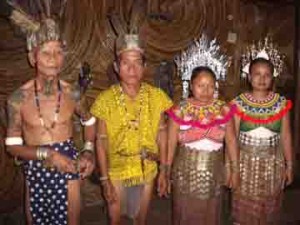Visiting a Dayak Longhouse is, by everyone’s account, one of the highlights of a visit to the state of Sarawak, Borneo. Some westerners, though, have an aversion to “roughing it,” and elect to go for a day visit, rather than an overnight stay. This is a mistake for several reasons, the chief of which is that this simple way of traditional life will soon disappear as Dayak children will become inexorably immersed in mobile phones, computer games, and rap music. The change hasn’t hit yet, but it will, just as it has in other traditional world cultures. Our recommendation? Go with a guide, stay overnight, have a drink with your hosts.
Go with a guide
We once made the mistake once of visiting the Ana Rais Longhouse in Borneo without a guide. This can easily be done, just drive up to the ticket booth, pay 20 Ringgit or so, and step on up. You’ll be able to appreciate the architecture, true enough, but the people won’t be welcoming, as you’ve got no one to establish protocol for you. It really is important, from a hospitality perspective, to follow protocol, meet the chief, bring a small gift or two for the village, and get introduced.
A couple of months later, we hooked up with a guide who took us to Kampung Serubah, 100 miles or so east of Kuching, up the Lemanak River, at GPS N01°13.969’ E111°45.852’. The Iban longhouse there, consisting of 24 apartments, is only 7 years old, but is a wooden structure built in the tradition. Chief Saong, some 80 years of age, was a gracious host, and performed a traditional warrior dance along with his sword, which originally belonged to his grandfather, and had taken many heads. Yes, heads taken in past raids are prominently displayed in the longhouse, but their sooty, aged appearance camouflages them a bit. They remain a token of luck and tradition (see James Ritchie’s headhunting articles on headhunting ritual and curing techniques).
We would not have been welcomed as well without our guide Anna, to be sure, and we feel a good guide is essential.
Stay overnight
So what will you miss if you leave before dark? You’ll miss the remarkable quiet of the longhouse shutting down after a long day. The working men come home in their boats, the women prepare dinner and corral the children, and the only sounds are human voices and maybe a distant generator. When the generator shuts down, a few kerosene lamps warm up the night, and voices can be heard laughing, talking, arguing, as they have for generations. The evening in traditional longhouses is a time to get together for good talk and cheer, and the old people are an essential part of the mix, as they reminisce. Those of us from industrialized nations might have only read about this type of evening life in books, and our guess is that it will be gone in 10 years. Experience it now, while you can.
Have a drink with your hosts
Longhouse people enjoy good cheer, and you’ll be treated to traditional dance and music. If you’re fortunate, the elders will dance and sing for you, and they enjoy performing for guests who appreciate their traditions. By arrangement, tour groups provide money to longhouse committees to keep up longhouse repairs, and help pay for longhouse events and rituals. Your guide will stop at a store and ask you to buy simple food gifts like crackers, biscuits, and candy, and we found watching the in-longhouse distribution channel a fascinating thing in itself, as no one gets left out. You will be offered a glass or two of rice wine, tasty and not overly strong. Please consider drinking with your hosts as a matter of conviviality, and buy a bottle, too. It’s only 5 ringgit or so, and you can then share as you pour for your hosts. In doing so, you will have bridged the gap between onlooker and host, and will have a rich experience you’ll remember for months to come.
In conclusion
There are 4000 some-odd longhouses in Sarawak, Borneo, Malaysia. Some are concrete, some are traditional wood. We like the wooden ones, and we like staying overnight. Bring a few simple toiletries, a rain poncho, and little else. Food, water, and simple bedding will be provided for you. Visit Malaysia Oasis’ Tours pages for some great Longhouse visiting options, including the tour we just described on the Lemanak River.

Leave a Reply